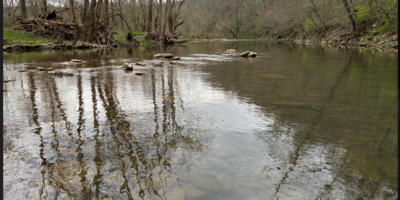Grants use art to teach about environmental issues
By Amber Scott
The tangled mass of construction netting, batteries, reflectors, Ken dolls, twisty straws and worthless motherboards sits, somewhat appropriately, atop overturned garbage cans. All this debris is spackled onto life-size dolls and re-imagined rocking horses thanks to epoxy, spray paint, nails and good luck.
It’s quite literally a hunk of junk, but ultimately the work in Bob Morgan’s All that Glitters evolves into a stunning army of environment-saving soldiers on a mission.
Morgan’s artwork, which is on display at Institute 193 (193 N. Limestone) through May 16, is just one of several projects funded by an EcoART grant from the Department of Environmental Quality.
Cheryl Taylor, commissioner of environmental quality, and her colleagues conceptualized EcoART grants during the spring of 2009. Taylor, who has six children, had seen the engaging and revolutionizing effect of art when her two youngest sons took classes at the Lexington Children’s Theater years ago and school concerts and plays overtook T-ball and soccer games on her calendar.
“As I became more involved in the arts community in Lexington, it just opened my eyes to the opportunity it has to teach people,” said Taylor. “That’s why [my assistant] Jaclyn [Phelps] and I made this grant up. We know that art reaches out to people in a very visual way, a very kinesthetic way. People learn and remember things much better than when they read it in a book.”
The Department of Environmental Quality managed to set aside $75,000 in its budget to fund the grants, and in December 2009, 21 grants were awarded to visual artists, musicians, environmentalists, educators and community activists to create projects that engage people with environmental issues like storm water, energy conservation, and recycling, among others.
“You can tell people thousands and thousands of times that the environment is important but until they really see the effects personally, whether it’s through art or another means, they aren’t going to really internalize it,” said Phelps. “You can’t always do things about global warming, but you can do things like anti-litter, you can do things like cleaning up your local watershed. You can do all kinds of things here in the city and really improve this local environment and make a huge difference.
“The whole point of the grants is to get people to internalize and educate them in a different way, in an unusual way.”
The EcoART grants weren’t the Department of Environmental Quality’s first foray into using art to raise environmental awareness. Taylor said the department, which is charged with managing landfills and providing trash service among other things, incorporated $15,000 for artwork into a grant for the installation of wetlands at McConnell Springs, which will officially open on Earth Day.
“The Friends of McConnell Springs added a mobile that Erika Strecker did, and it moves when the wind blows,” she said. “So many people have come out to the park to see that and then they see the place and they enjoy it so much, we thought that’s a pretty striking way to get people’s attention.
EcoART events in the summer
EcoART-funded events and exhibits like All that Glitters are ongoing into the summer. Jan Durham has created an educational display of Kentucky wool that will be at Central Library through April. Students from Sts. Peter & Paul will give a dramatic performance at Gratz Park on Arbor Day, April 30, in celebration of a LexTree Walking Brochure. Statues and furniture made of recycled plastic will be exhibited at the 5th Annual Peace & Global Citizenship Fair on May 15, and an exhibit of environmentally-themed work by artists Murray Dwertman and Hui Chi Lee will open at the Downtown Arts Center at the end of May.
Other projects, including a film screening, a rain garden, and stepping stones in the Distillery District, will be rolling out soon, but details are still in development.
Many of the projects, be they gallery exhibits or school performances, have supplemental educational components. In the case of All that Glitters, Bob Morgan has led discussions with school and community groups and encouraged classes to take in and experience the art created from the grants.
Taylor said the Department of Environmental Quality hopes to not only continue the EcoART grant program next year, but also expand it by $25,000. Budget approval is pending.
“We should have done this a long time ago,” said Taylor. “To me it’s obvious what people can learn when you take a look at some of the things we’ve created with this program. People are using all different types of media to help people understand that you are the environment, the environment is you. It’s wonderful.”
For more information about the EcoART grant program or projects, visit http://lexingtonky.gov.




Leave a Reply